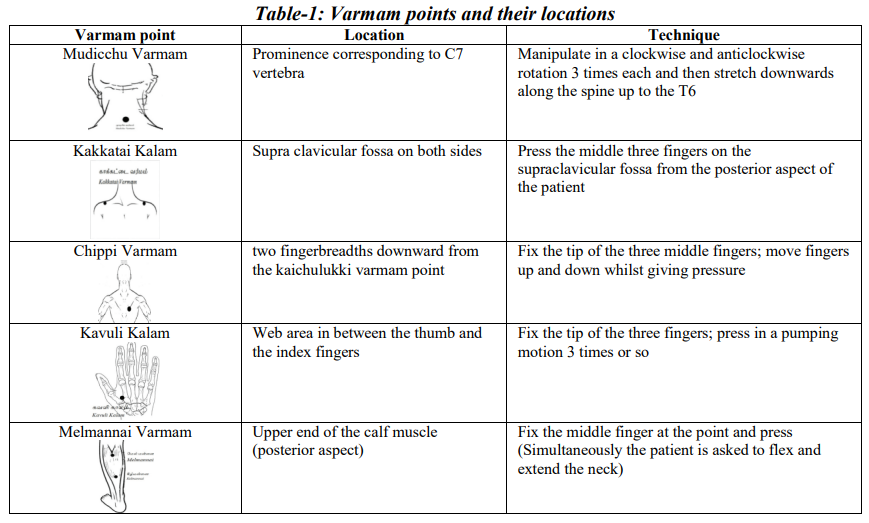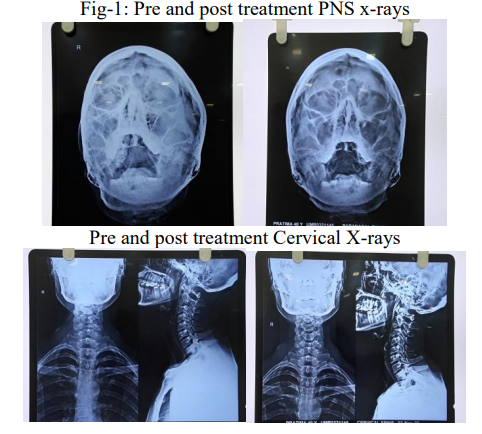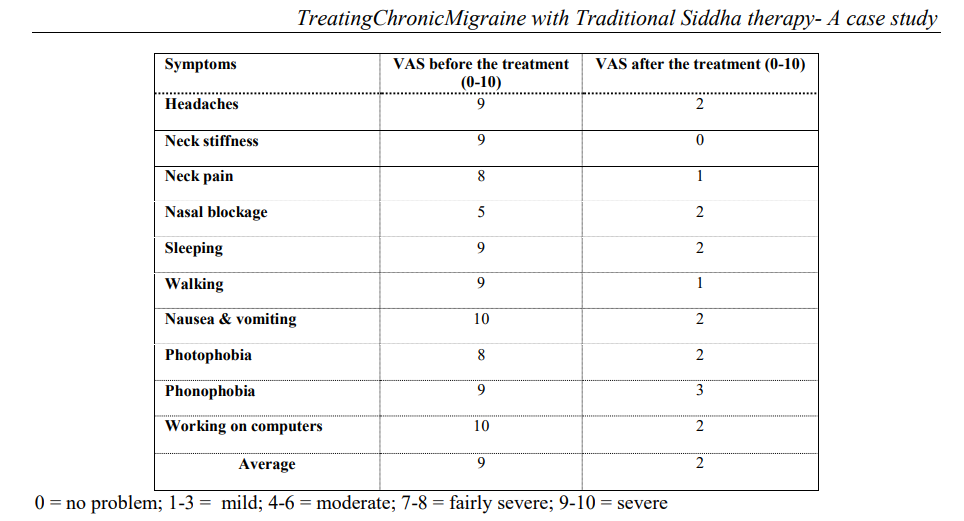Migraine is a chronic paroxysmal neurological disorder characterized by recurrent attacks of moderate to severe headache with associated symptoms such as nausea, vomiting or dizziness. The most characteristic symptoms associated with migraine include photophobia, phonophobia, and gastrointestinal symptoms while few may also have a primary complaint of dizziness, ear pain, or head heaviness (Thalai Kanappu), “sinus” pain (Peenishangal), and even neck pain . Routine physical activity, movement, or even throat infection (Kural Kammal), running nose (Naasi neer paaychchal) can worsen the headache .Migraines occurs mostly in the morning time, especially upon waking. Patients with chronic migraine experience migraine symptoms for 15 days or more in a month over a period of 3-4 months. During the episode people feel exhausted or weak but otherwise are usually symptom-free between attacks.Some people have migraines at predictable times, such as before periods or after stressful work.People who suffer from migraines can clearly identify the triggers like alcohol, a certain type of food items, allergies,sunlight, loud noises and certain odors or perfumes, irregular sleep,and missing meal.
The prevalence of migraine is on a rise globally. It is thought that around 12.8% of the world, population is affected by migraine. According to statistics, about 7%–10% of all headache patients convert into Chronic Migraine patients; it is observed that migraine is more in females as compared to males with ratio of 3:1. Studies show migraine to be a major cause of limiting day-to-day activities of daily living. Those having migraine attacks have a higher chance of developing sleep disorders, depression, anxiety and fatigue. Thus, the economic and social burden of migraine is substantial, affecting patients’ quality of life in terms of work, social activities and family life. Migraine is currently the third leading cause of Years Lived with Disability/Disease (YLD) among individuals under 45 years of age with peak incidence of occurrence in adolescence and peak prevalence in middle age. Studies do support for its presence in about two third of the cases in the family .In recent years, the management of migraine has advanced but there remains a group of patients who continue to experience disabling headache despite optimal treatment. These patients remain “refractory” and fails to respond to standard treatmentseven after avoiding all migraine triggers.
The management of migraine includes identifying the primary cause & headache type, addressing all associated factors, and treating both with medications and behavioral treatments. Though, conventional treatments give satisfactory result but can cause side effects so migraine sufferers find Complementary and alternative medicine (CAM) therapies as a better option. A study in China showed among 690 patients with headaches, 492 were using CAM, out of which 46.4% were suffering from migraine. Ayurveda,massage therapy,Acupuncture, meditation&yoga therapy, cognitive behavior therapyare some of the popular methods of CAM . The reason for acceptance of these therapy techniques is due to their simplicity and use of natural medications causing no side effects.
Siddha therapy is also one such unique, ancient alternative treatment process popular in Southern part of India. It relies mainly on natural remedies, dietary and lifestyle changes to cure a particular condition, it has been found effective in curing migraine as well. In Siddha, Migraine is described as Mandai soolai(severe headache) and is classified under kaba diseases. The physiological functioning of the body is mediated by three humours, namely Kabam, Pittam and Vatham. The popular belief in the Siddha system is that headaches occurs when two out of these three humoursare dearranged. Many Siddhakars believe that when Silethuma naadi or Kaba naadi goes out of balance, it would result into headaches or migraine. The line of treatment focuses on normalizing the balance of the humour, so the disease is cured and body normalcy is regained. Siddha is widely practised in India but there are no well-documented studies evaluating its safety and efficacy. Hence, the aim of the study is to emerge Siddha therapy as a new treatment option for migrainewith no side effects and helping incutting the expensive cost for medications which the patient has to take for many years; providing positive health benefits and improving quality of life
In this article, we present a case report of 40 year old woman with Chronic Migraine from last 22 years who underwent 4 siddha sessions for reliving the severe headache and had a good result without complications. The symptoms presented by patient at time of admission like sleeplessness, stiffness in neck, headache associated with nausea & vomiting which were at scale 9 (severe) was lowered to 2 (mild) on completing the treatment.
A 40-year old female from Hyderabad visited Department of Siddha, Chakrasiddh in Sept, 2022 with complaints of throbbing pain in right temporal region, watery eyes associated with nausea and vomiting from last 3-4 days. Headache occurred 3-4 times every day with severe intensity and use to last for 2 hours everytime. Headache was alternating in right side or in left side but dominantly on right side. She noticed the stiffness in her neck in morning times which use to reduce as day passes but headache intensity use to increase in day time. Her triggers were mainly sunlight and loud noises along with stress of work at office. The associated symptoms presented by patient at time of admission were sleeplessness, headache associated with nausea & vomiting and anxiety.
On taking complete medical history, there is no significant family history identified, but the patient complained of gut issues mainly related to constipation atleast twice every week. The patient is non-diabetic, non-hypertensive and recently was diagnosed with hypothyroidism but the condition is well under control with the help of allopathic medications. She is pure vegetarian, non-alcoholic, and non-tobacco user. Her vitals were within normal limits. On general examination, there was no pallor, icterus, clubbing of nails or oedema noted. Routine CBC and urine investigations as well as CT scan of brain were carried out and findings were not of any pathological significance though CT brain showed mild Maxillary sinusitis. Her daily headaches with Visual Analog Scale (VAS) score up to 9 and Migraine‑ Induced Disability Assessment Score (MIDAS) about 72, indicating severe disability. The patient was initially diagnosed for migraine in the year 2012 and was put on painkillers as and when required. The pain killers gave her temporary relief in migraine. From last few years, the attacks have increased both in frequency and intensity of pain. These attacks were shifting from right and left but more in right temporal region. The pain was throbbing in nature with severity 9 on VAS and was associated with vomiting. She consulted many allopathic physicians but got symptomatic relief only. She consulted a neurologist who gave Botulinum toxin A injections in neck six months but then resistance to the drug developed and pain continued.
From last 1 year due to office problems, her anxiety levels were increased leading to frequent attacks of migraine with more intensity. Infact, from last few months, she was working from home due to travelling and sound which was initiating her headache episodes more. She was also avoiding her family functions and dayouts with family so her family life was getting perturbed. She was having low blood pressure and her weight was decreasing. While examination, her BP was 100/70 mmHg and weight 59 Kg. In recent past her pain scale was aggravating even by routine physical activity and wasoften accompanied by nausea or vomiting, so she wanted a treatment in Siddha which help her lead a normal life and treat her without medications.
PThe treatment was started on 30th June, 2023; it was planned for 10 days for Cervical stiffness along with 3-4 sessions of Migraine twice a week. The patient had complaints of severethrobbing pain in right temporal region, watery eyes associated with nausea and vomiting.Patient was advised to do physio exercise for 1/2 hr and practice yoga includingasanas, pranayama’s, and meditation for one hour to lower her anxiety levles. With that she followed proper diet and siddha treatment as prescribed.External therapies are really helpful in this condition and gives a remarkable relief. Hot water fermentation along withsteam inhalation (Vedhu)& nasal applications (Nasiyam) were been advised to be done twice daily to the patient.
In initial week, patient could see difference in her neck stiffness. She could notice that she was able to sleep well for 8 hours while earlier she could not sleep even for 2-3 hrs without disturbance. Pain in neck reduced from 9 to 4 in just first week. She also was advised to reduce her medications in a weeks time so that her dependency on pain killers is reduced and the outcome of siddha therapy can be visualized. On 7th day of treatment, the patient underwent the sinus session done by Chief healer who performed the procedure by hand pressure therapy (Varmam) along with some hard strokes on the cervical region. She initiated by pressurizing her fingers into nasal cavity and manipulating with fingers. She used different hand pressures like Thadaval and Amartthal to stimulate "varmam" points at neck and nasal area.The Varmam points that are stimulated to achieve a therapeutic effect in the treatment of patients diagnosed with Cervical Spondylosis and migraines in Siddha therapy are mentioned in Table-1.


These treatment protocols continued for 10 days along with internal medications in tapering way and was stopped within 8 days. The patient was able to see changes in the intensity of headache and its duration even after not taking her medications. Earlier she felt heaviness in frontal portion but after sinus treatment, she felt relieved. She felt better in breathing and headache intensity was 5 on VAS. She had started going to her office from 5th day and was now comfortable with sounds though by the evening time, she could feel heaviness but intensity was less as compared to when she joined. On 9th day, the chief healer did her Gut session due to some constipation issues which she was having since 10 years. Studies shows constipation, acidity can be one of the reason for migraine. For concentration and anxiety, a meditation for 10 mins was been followed. Her dietary regimen included Alkaline foods with less oil, salt and spice. The diet was pure vegetarian with lowcarbohydrates, and protein-filled diet.
These treatment protocols continued for 10 days along with internal medications in tapering way and was stopped within 8 days. The patient was able to see changes in the intensity of headache and its duration even after not taking her medications. Earlier she felt heaviness in frontal portion but after sinus treatment, she felt relieved. She felt better in breathing and headache intensity was 5 on VAS. She had started going to her office from 5th day and was now comfortable with sounds though by the evening time, she could feel heaviness but intensity was less as compared to when she joined. On 9th day, the chief healer did her Gut session due to some constipation issues which she was having since 10 years. Studies shows constipation, acidity can be one of the reason for migraines. For concentration and anxiety, a meditation for 10 mins was been followed. Her dietary regimen included Alkaline foods with less oil, salt and spice. The diet was pure vegetarian with lowcarbohydrates, and protein-filled diet
After the 15th session, the patient was asked to come only once a week for next 4 sessions and was advised to notice all developments in her symptoms. In all next 3 sessions & 1 gut session, she was monitored for feedback related to her sleep and headaches intensity. At the end of treatment, the symptoms presented by patient at time of admission like sleeplessness, stiffness in neck, headache remarkably improved. Depending upon the feedback, X-rays were taken out for pre and post appearance of PNS and cervical region (Fig-1).

Significant changes in signs and symptoms were noticed before treatment and after treatment results. The patient showed no symptoms for vomiting in the gaps; however sometimes she had nausea due to smell of food. She felt decreased heaviness in frontal head region and no severe migraine attacks. She was able to sleep for 8-9 hrs without disturbance and was able to do walks for 40 mins. The most important development was she was not taking any NSAID’s from last 10 days and was able to attend to her office and other family functions. She was not having any constipation issues after the gut session. On last session, Visual Analog Scale (VAS) score along with Migraine‑ Induced Disability Assessment Score were determined. VAS score reduced from 9 (severe) to 2 (mild) and MIDAS score which was 72 (severe) came to 19 (moderate disability).(Table2,3) On 1st and 2nd follow up there was no attacks of migraine in between the course of duration.

Migraine is an episodic neurovascular disabiling disorder which is closely related toMandai soolai(severe headache) and is classified under kapa diseases in Siddha. Siddha believes in treating the disease at its root cause from within by using its unique treatment methods and initiating the Varmam points.These treatment approaches create a balanced physiology which brings healing to the body and mind. The main reason for most of the people choosing Siddha is due to its simplicity. Moreover, another foremost reason is due to less or no side effects when compared to usage of antibiotics. This helps to achieve complete treatment as well as control of migraine to the patient. This Chronic migraine case shows positive result and improved quality of life indicating the therapeutic efficacy of Siddha treatment. It has opened new doors for treatment of migraine through holistic approach where there is no permanent cure for migraine. Siddha therapy can be used as a new treatment option among practitioners of new era. This would help incutting the expensive medication cost with positive health benefits thus improved quality of life.

© 2023 by Chakrasiddh. All Rights Reserved.